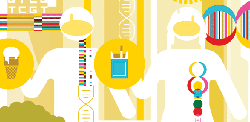Where DNA meets daily life

The intersection of genes and the environment is the new target of public health research.
Red hair is a genetically determined trait. And when redheads with Celtic roots move to sun-drenched countries near the equator, their risk of skin cancer dramatically rises. But the risk may not only be tied to the fact that redheads tend to have fair, unpigmented skin that is more susceptible to high doses of ultraviolet light. Some studies suggest that even olive-skinned women with a particular “red hair color” gene face a higher risk of skin cancer.
Red hair and skin cancer: a classic case of gene-environment interaction. What scientists don’t fully understand is why. What is going on in cells with “red hair color” genes that confers the extra risk—a risk that goes beyond the well-documented increase in ultraviolet-induced DNA damage in people who lack UV-absorbing pigment in their skin? And how do these genes in turn influence other biological processes that lead to skin cancer?
That dance between genes and environment is the focus of a burgeoning field of public health research—one that could someday have a big payoff. By revealing the biological underpinnings of disease, it could bring new and improved methods to diagnosis, treatment, and prevention. Ultimately, it could help corroborate and refine—or, perhaps, rewrite—many of today’s standard public health recommendations. “We are not just doing basic science. We are addressing important public health problems from a fresh perspective—using genomic and mechanistic studies,” says Quan Lu, Mark and Catherine Winkler Assistant Professor of Lung Biology in the Departments of Environmental Health and of Molecular Metabolism.
Gene-environment studies describe the complex ecology of disease. If smoking is the most common cause of lung cancer, why do only 10 to 20 percent of heavy smokers develop the disease? Why do most patients initially do well on asthma medications, while a fraction eventually fail to respond to the drugs? Why are rates of breast cancer high in the United States, compared to other parts of the world—though, even in the U.S., most women do not develop the disease?
Public health scientists are in a unique position to answer these questions because of their access to large population-based cohort studies. These studies, replete with lifestyle and demographic data, include the Nurses’ Health Studies, the Health Professionals Follow-up Study, the Physicians’ Health Study, and the Normative Aging Study—all efforts in which HSPH faculty have had long affiliations. “At the School, we’re in a great position, because our data sets are drawn from studies that have been collecting detailed information about exposures for 30 years,” says Peter Kraft, associate professor of epidemiology.
Redefining “Genes” and “Environment”
In gene-environment studies, scientists are not just interested in inherited genetic mutations. They are also examining what turns genes on and off. And they are looking at “epigenetics”: changes in proteins—the molecules synthesized by genes and involved in virtually all cell functions—caused not by alterations in the DNA code, but by shifts in the cells during biologically sensitive periods (an epigenetic cause of vaginal and cervical cancer, for example, is exposure in the womb to the chemical DES).
Likewise, researchers are expanding the definition of “environment” beyond conventional meanings such as air pollution or radiation exposure. They are exploring how genes are influenced by anything to which the body is exposed: diet, exercise, drugs, bacteria, UV sunlight, and workplace hazards, to name a few.
In fact, it is only by taking environment into account in their studies that researchers can identify the genes that interact with environment.
Recent reports in the New York Times and elsewhere have noted that the Human Genome Project—the 13-year effort to identify all of the approximately 20,000-25,000 genes in human DNA—hasn’t delivered on once-promised preventions or cures. The genome-wide association studies, or GWAS, spawned by the Project have largely not turned up links between common gene variants and greatly elevated risk for major diseases such as breast or prostate cancer, heart disease, or type 2 diabetes. Put another way, these common genes do not predict the risk of developing disease any better than a family history or lifestyle information.
But that may be because the studies only looked at genes—not at the environments that could have influenced those genes. Today, research groups are going back and incorporating data from those same individuals—data such as behaviors, personal characteristics, height, weight, diet, etc.—to see if the genetic pattern varies according to environmental exposures. If it does, then that could point a spotlight on genes associated with the disease.
Discarding Old Theories
Gene-environment research reflects a broader change in the scientific landscape. No longer do scientists assume that single genes cause single diseases. Except for classic single-gene conditions such as Huntington’s disease—in which everyone who carries the defective gene and lives long enough will develop Huntington’s devastating neurological symptoms—most diseases are the upshot of both genes and environment, with the activities of genes greatly modified by environmental exposures. Moreover, genes appear to work in concert with other genes to raise (or lower) the chance that, under certain environmental triggers, a person harboring those genes could develop a disease.
As gene-environment analyses get more fine-grained, what we think of as one disease may turn out to be several diseases, with different underlying causes and treatments. Diabetes, for example, can be triggered by obesity—but also by exposure to arsenic. The first condition responds to insulin and weight loss; the second does not. According to Lu, “The idea will be to design, not only disease-specific, but also subdisease-specific therapies.”
Genes Determine Drug Response
Indeed, some of the clearest examples of gene-environment interaction are in pharmacogenetics. A patient’s genetic profile can help predict whether that person will respond to certain medications, or face the chance that the drug will be toxic or ineffective.
Gene-environment studies will also help scientists sharpen their estimates of disease risk. Initially, scientists had assumed that genes and environment had a synergistic relationship—with genes and environment interacting in a way that was more than the sum of their separate risks. But according to David Hunter, Dean for Academic Affairs and Vincent L. Gregory Professor in Cancer Prevention in the Departments of Epidemiology and Nutrition, “Most disease risks just add—they don’t multiply in a synergistic, jackpot sort of way. You’re worse off if you’re exposed to the adverse environment and to the adverse genetics. But you’re not spectacularly worse off. They add. But together, they can still add up to substantial increases in risk. The implication is that if you’re genetically exposed, there’s even more reason for you not to be exposed to the environmental factor.”
Lifestyle Trumps Genes in Breast Cancer
In a March 2010 paper in the New England Journal of Medicine, Hunter and his colleagues showed that, although a set of common gene variants were clearly associated with the risk of breast cancer—and predicted breast cancer risk as well as, or better than, the method that doctors often use, which is based on a patient’s demographic and lifestyle profile—these latter risk factors still played out at every level of genetic risk. In other words, no matter what you inherit in terms of common gene variants, maintaining a healthy weight after menopause, limiting alcohol intake, and being prudent about hormone replacement therapy remain important ways to reduce the threat.
Genes to Policy
Gene-and-environment research could well shape public policy and medical practice. Understanding more about the mechanisms of disease will undoubtedly lead to new treatments. It could also bolster existing public health wisdom about prevention. “Our work may reinforce the idea that cockroaches or air pollution contribute significantly to asthma—because we have the genetic mechanisms to show it,” says Lu.
Policy Quandaries
Gene-environment research could also introduce policy quandaries. The more scientists identify and fine-tune the genetic factors behind disease or drug response, the more doctors will want to screen individuals for gene variants in order to tailor medical care. Such personalized medicine may well lead to higher health care costs. According to Hunter, “There’s every chance that this genetic knowledge, rather than making medicine more rational and saving health care costs, will drive greater use of screening or prophylactic therapies.”
If not communicated well, the findings from gene-environment research could even backfire. “If you found a set of genes that made people highly resistant to the effect of smoking on lung cancer—and again, that’s a hypothetical—it’s unlikely that those same genes would make people resistant to the other bad effects of smoking, like heart disease. So it wouldn’t change public health advice one iota,” says Hunter. “If you tell people they’re genetically more susceptible to a particular disease, they may be more motivated to adopt healthy practices. But people who are less susceptible might mistakenly ignore these. It could be a net negative.”
Which means that, paradoxically, modern genomics may underscore old-fashioned, broad-brush, public health advice, says David Christiani, Elkan Blout Professor of Environmental Genetics in the Departments of Environmental Health and Epidemiology. Christiani found a common gene variant that made Shanghai cotton textile workers more vulnerable to lung disease. The practical implication of that discovery, Christiani argues, is not to screen out workers who harbor the gene, but to impose stricter environmental standards overall. “Protecting the most vulnerable among the population protects everyone better,” he says. “For most disease risk, you can control the environment better—because that’s what’s controllable. You’re not going to genetically engineer disease out of the population.”
“Lung cancer and diabetes are two good examples of retaining current recommendations,” adds Kraft. “You shouldn’t smoke and you should maintain a healthy weight. Regardless of your genes, that’s great advice.” As the era of public health genomics unfolds, we may have even stronger backing for today’s common wisdom—and new evidence for other ways to protect the health of populations.
—Madeline Drexler is editor of the Review. Illustration by Celia Johnson. Photos by Kent Dayton.


